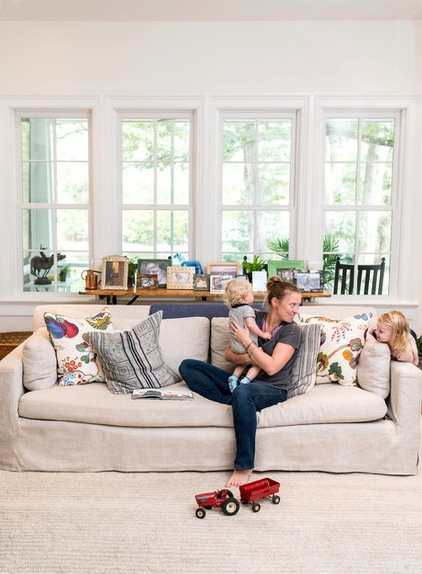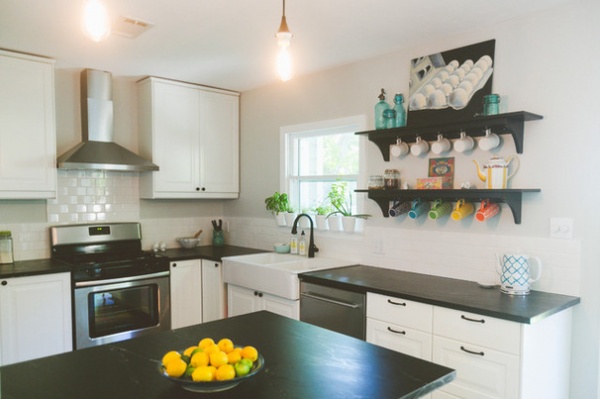Relocating Help: 8 Tips for a Happier Long-Distance Move
http://www.decor-ideas.org 09/03/2015 02:13 Decor Ideas
We all know about turning on the utilities at the new place and filling out the change-of-address form for the postal service, but when you make a long-distance move, some other things come into play that can make getting from here to there a bit trickier. Here are nine tips pulled from my recent experience of moving from the East Coast to the West Coast — from packing the moving van to handling the inevitable meltdowns.

1. Maximize space in the moving van. Moving cross-country is not cheap (I can only imagine the cost of moving overseas), so I did a lot of reading and asking around for tips before we packed up our house, to make sure we made the most of the space in our truck. Now that we’ve made it to the other side, I can say with confidence that these are the top three packing steps I would do again in a heartbeat:
Declutter before you pack. If you don’t love it or need it, there’s no sense in bringing it with you — that space in the truck is money!Leave dresser drawers filled. For the first time ever, rather than emptying the dresser drawers, I simply left the clothes and linens folded inside and wrapped up the furniture. Does this make them heavier? Yes. But as long as the drawers are filled with lightweight items (definitely not books), it should be fine. And if not, you (or your helpers) can carry the drawers out separately. The benefit is twofold: You need fewer boxes, and it will be easier to find stuff when you move in.Pack soft items in black trash bags. Glamorous? Not in the least. But this has to be the smartest packing idea we tried. Fill heavy-duty black garbage bags with soft items (duvets, pillows, stuffed animals), then use the bags as space fillers and cushioning inside the truck. To keep items clean and protected, we doubled the bags and tied, then taped, them shut. Use a permanent marker on sticky labels applied to the outside to note the contents.

2. Paint before you move in. If you plan to give your new space a fresh coat of paint, it makes a lot of sense to do this before moving all of your stuff in. Aside from the obvious (it’s easier to paint an empty house than one full of furniture), you’ll feel a great sense of accomplishment having “paint” ticked off your to-do list before the first box is even unpacked. While you’re at it, if there are other messy, disruptive items on your list (anything to do with the floors definitely qualifies), getting to as many of them as possible before moving day will be a big help.

3. Ask around before signing up for services. Depending on where you’re moving, there may be many or very few choices of service providers for things like phone and cable. If you have some options, take the time to ask around before committing to one — you may find that the company that served you so well back at your old place doesn’t have much infrastructure in the new area. Or you might find, as we did, that (thanks to lousy cellphone reception) a landline is a necessity at the new place, even though using only cellphones worked fine at the old house.

4. Put ‘Buy houseplants’ at the top of your to-do list. One of the unexpectedly sad moments of our move was when I realized we couldn’t bring our houseplants along. This may not sound like a big deal, but when you’ve lovingly nurtured a houseful of plants for years, the thought of starting back at zero is kind of depressing. We gave away all of our plants but ended up keeping some of our favorite pots — something that has made picking plants for the new space much easier (and cheaper).
Once you’re in your new place, you might be tempted to put off buying new houseplants, but I urge you to make it a priority. Why? Houseplants clean the air (especially important if you’ve used paint or flooring that has volatile organic compounds, or VOCs), but most important, they will make your house feel like home.

5. Give yourself time to get used to a new climate, time zone and culture. After moving from New England back to the San Francisco Bay Area, I’ve been amazed at how long it’s taken to feel “settled” — even though I’ve moved back to my hometown! Building in extra time to handle that adjustment period can be a relief, especially for families with kids. A week or two to catch your breath (and track down the best local ice cream parlor — priorities, you know) will put everyone in better spirits.

6. Expect some meltdowns — from children and adults. Moving is hard, there’s just no way around it, but moving long-distance is especially hard. It means leaving behind friends, schools, jobs and perhaps family and entering a great unknown, new place. Even if the new place sounds great (and is great!) meltdowns and emotional moments are a totally natural reaction to such a big shakeup in life. So when the moment comes (and it will) that someone (or more than one someone) in the house needs a good cry, roll with it. Then get yourselves up and find something fun to explore or do in your new town.

7. Expect to shed some more stuff after you move. No matter how much decluttering you do before moving, it seems to be a law of nature that there will be items that simply don’t fit in the new space. Even if everything physically fits, there’s bound to be something that just doesn’t work like you thought it would. Try not to hold on to these things purely out of frustration. Sell them, gift them to a dear friend or (if you truly love the items) keep them — but only if you have the storage space.

8. Also expect to buy some stuff after you move. But we just gave so much stuff away! It’s not fair! I know. But each home has its quirks, and those quirks demand new stuff. For instance, perhaps your old kitchen had a huge island with plenty of space for cooking prep and for stools to pull up for breakfast, but the new kitchen has a big empty spot right in the middle of the room that requires a portable island or a kitchen table and chairs. Earmarking a bit of money for these kinds of things can help you set and stick to a budget.
Tell us: Been through a long-distance move? What was the most surprising thing you had to deal with? Your best tip? Share your thoughts and stories in the Comments.
More
9 Ways to Calm New Home Jitters
The All-in-One-Place Guide to Selling Your Home and Moving
Related Articles Recommended












